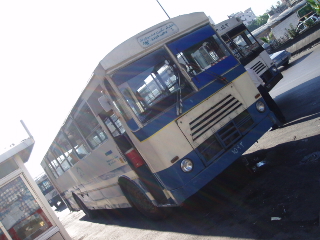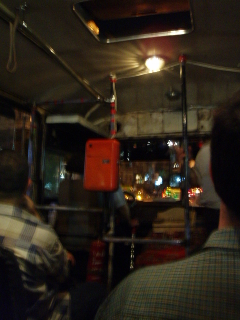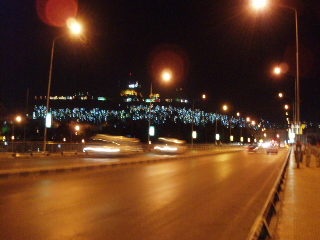Day three in Syria is spent on a day trip to Bosra, a town 100km south of Damascus.
Designated as a UNESCO World Heritage site, Bosra is an intriguing place: you see historical ruins from various periods of the town's history. Plus, it's not yet to be "touristized": the townspeople are very laid-back and hassle against tourists is kept at minimum.
Let me show you around a wide variety of ruins in Bosra chronologically. We met a local guy who has joined the excavations by European archaeologists in Bosra and now studies archaeology at Damascus University. He guides us around the town's ruins. His explanation nicely supplements what's written in the Lonely Planet. (All pictures below can be cliked to enlarge.)

This is the gate of a Nabataean palace. The Nabataeans are pre-Roman civilization in Arabia. Bosra was the capital of the Nabataean kingdom for a short period in the 1st century AD.
Behind the gate spread the ruins of what is thought to have been a Nabataean palace. According to our guide, a Byzantine complex was built upon the ruins sinking in the sand. So we see something like this:
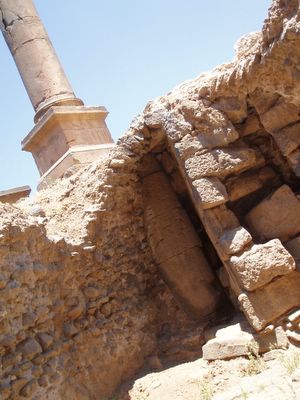
Below a Byzantine column lies the ruins of a Nabataean palace.
When Romans conquered Syria and the surrounding region, Bosra became the capital of the Province of Arabia. They built their characteristic colonnaded straight roads like this:
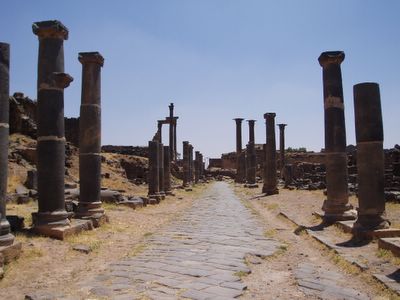
What makes Bosra beautiful is the use of black basalt blocks for buildings.

A paved plaza of the Roman market
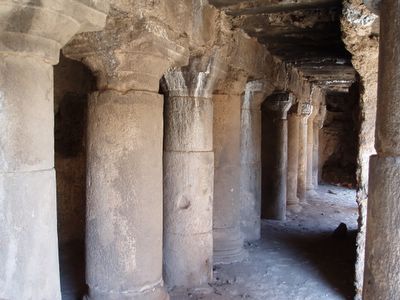
The basement of the Roman market

A public bath behind the Roman market

The Gate of the Lantern - a Roman triumphal arch dating from the early 3rd century. What's seen behind the gate is a modern house, built with stone scavenged from the ruins, where a Bosran family lives.
By the way, we see a friend of our guide sitting under the triumphal arch. He may be a resident of the modern house next to the gate. He calls himself
Haga Kenji, a grade-B celebrity in Japan (one of those only appearing in tabloids). How could he know such a low-profile-abroad celebrity in Japan? A Japanese tourist must have told him he looks like the guy (and he actually does, which makes me laugh hard).

Birket al-Haj (meaning the Pool of the Pilgrimage), created as a reservoir during the Roman era. As the name suggests, Bosra was a popular rest stop for pilgrims on their way to Mecca.

Four towering Corinthian columns upon which an aquaduct to the public baths was thought to pass during the Roman era (according to our guide).
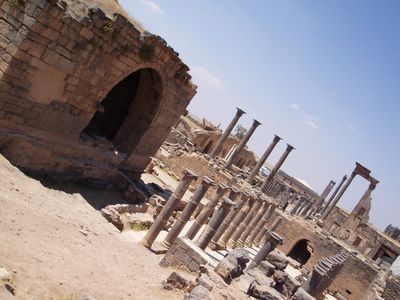
The ruins of the Roman public baths, with a view towards the north of the town.
After the east-west split of the Roman Empire, Bosra fell under the rule of the Byzantine Empire and became "the seat of a primate overseeing 33 priests" (the Lonely Planet, p.123).

The ruins of a Byzantine cathedral (built in 512, the largest in the region at that time), which Emperor Justinian used as the model for cathedrals in Constantinople and Ravenna. The place is now surrounded with fences and the locked door. You have to pay a bit of money to the guard to enter.

A mosaic found in the ruins of the Byzantine cathedral (according to our guide), now hung on the wall of the theatre-cum-citadel (see below).
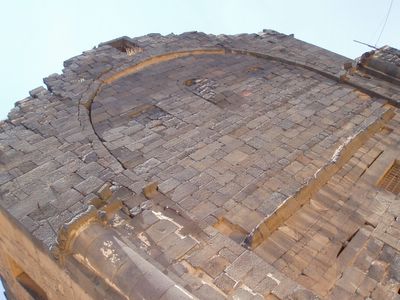
The facade of the monastery (built in the 4th century) where Mohammed met a monk named Boheira who revealed his future as the Prophet. Because of this legend, Bosra is a bit sacred place for Muslims.
After the advent of Islam, a couple of mosques were built in Bosra, which became part of the pilgrimage route to Mecca.

The minaret of the Mosque of Omar - some say it was built by Caliph Omar, who conquered Syria in 636, while it was actually constructed in the 12th or 13th century (according to the Lonely Planet).
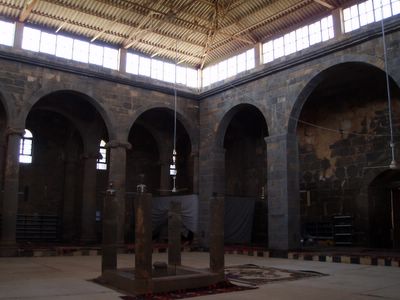
Inside the Mosque of Omar, which is still used as Bosra's main mosque.

Columns inside the Mosque of Omar. The left column was built during the Byzantine time - the mosque had been a church before the advent of Islam - and the right one was built by Muslims - they extended the exisiting church to use it as a mosque. What's interesting is that Muslims iminated the Roman-style columns.
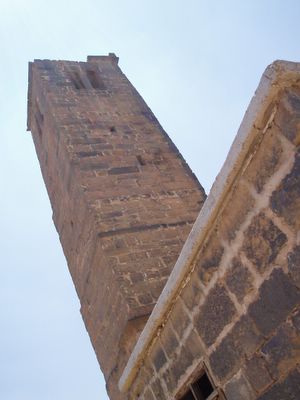
The minaret of the Mosque of Fatima, built in the 11th century and named after the Prophet Mohammed's daughter - probably because next to the mosque stands the monastery where Mohammed was told he was going to be the Prophet.

Inside the Hammam Manjak, built in 1372 to serve as a bathhouse for pilgrims.
Okay, now it's time to visit the famous Roman theatre in Bosra. This is a unique construction because Muslims later fortified the theatre by surrounding it with thick walls and eight towers.

This is a view of the theatre-cum-citadel from outside. Slits on the wall are where arrows come from against enemies (what Muslims had in mind were Crusaders).
After entering the citadel, walking through dark fortress halls, and climbing up staircases, what suddenly comes into my view is... (
click here).
That is a view of the arena and the stage from a backseat.

Seats of the Roman theatre, divided into three parts - the lowest was for the noble, the middle for citizens, and the highest for slaves.

A view of the seats from the arena. The columns on the top were used to support a canvas(?) roof of the theatre (according to our guide).
Bosra became a desolate town during the Ottoman times. The theatre-cum-citadel was deserted and buried under the sand. That's probably why the theatre is well-preserved. The accoustics inside the theatre is amazing. Your voice and the sound you make in the theatre is naturally amplified and echoed. The theatre is back in use once every other year (in odd years) as a venue for Bosra Festival. Two weeks in October see various performances from all over the world. If you plan to visit Syria, bear this in mind when you decide when to go.
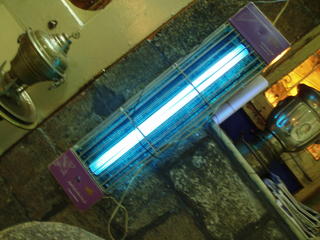






















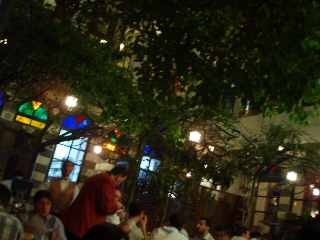




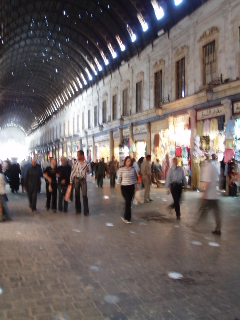
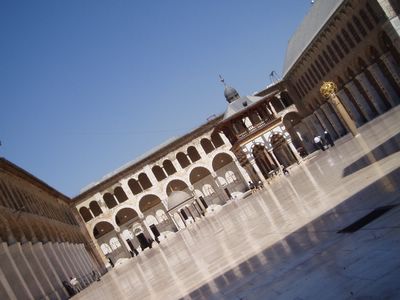
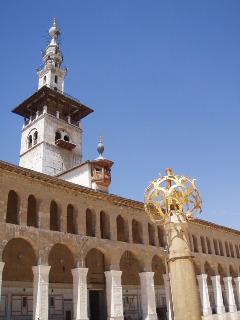
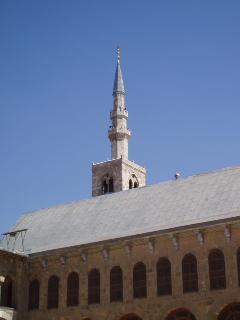
 (viewed from ouside)
(viewed from ouside)
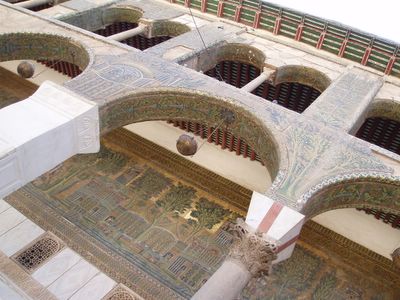
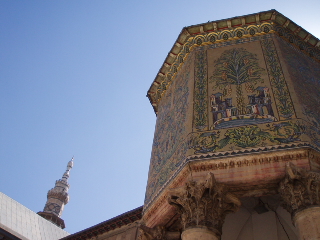 The Dome of the Treasury in the courtyard (with Al-Gharbiyya Minaret on the left).
The Dome of the Treasury in the courtyard (with Al-Gharbiyya Minaret on the left).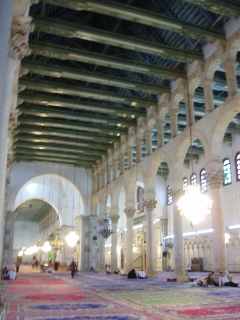

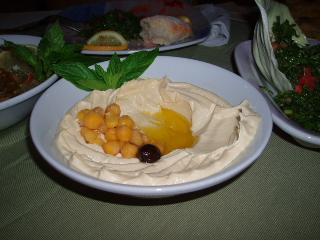

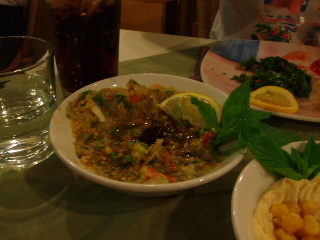 But the most impressive is baba ghanoug (an eggplant salad with diced tomato, onion, parsley, garlic and lemon). Like hummus, it's eaten with Arabic bread used as a scoop.
But the most impressive is baba ghanoug (an eggplant salad with diced tomato, onion, parsley, garlic and lemon). Like hummus, it's eaten with Arabic bread used as a scoop.